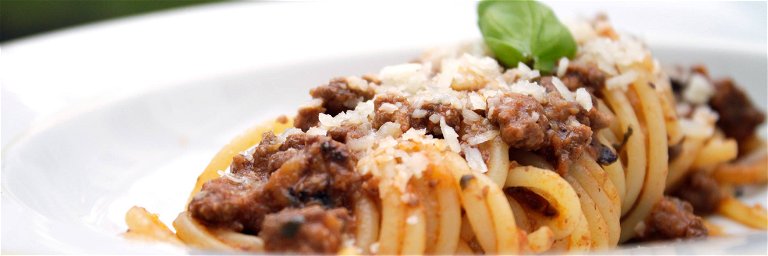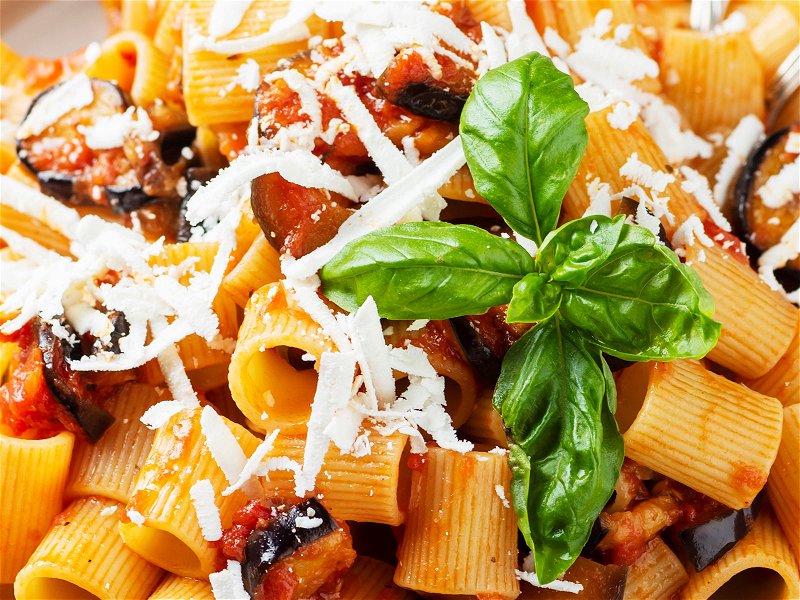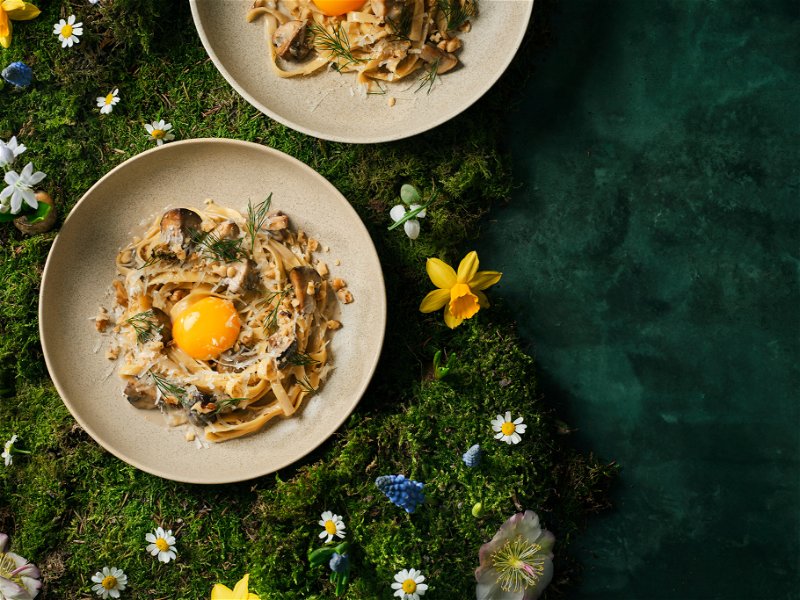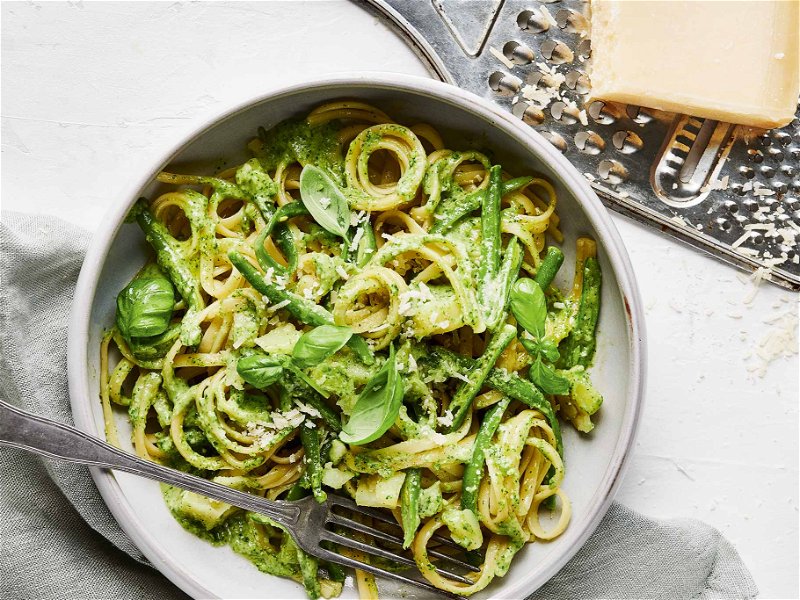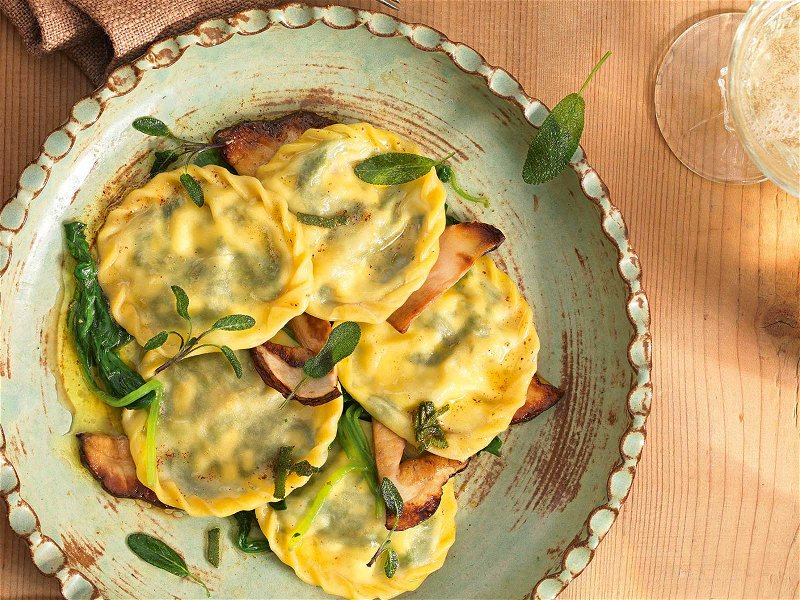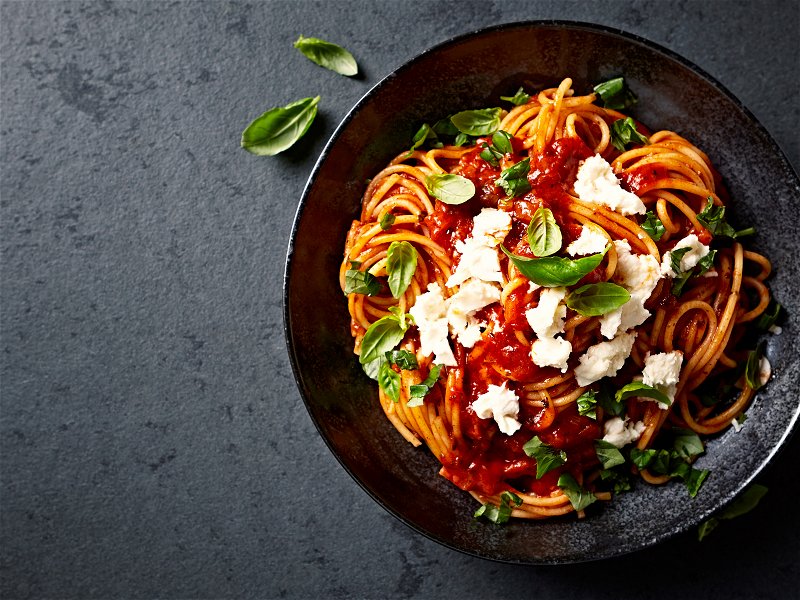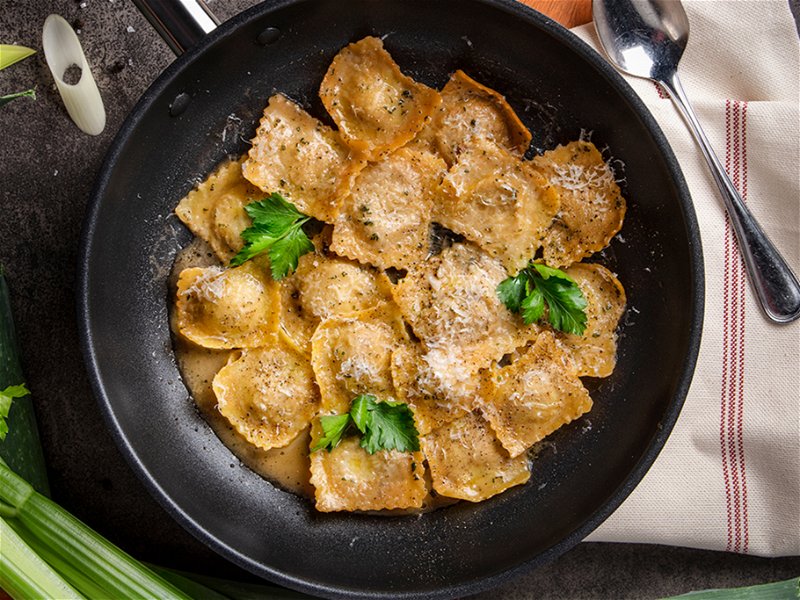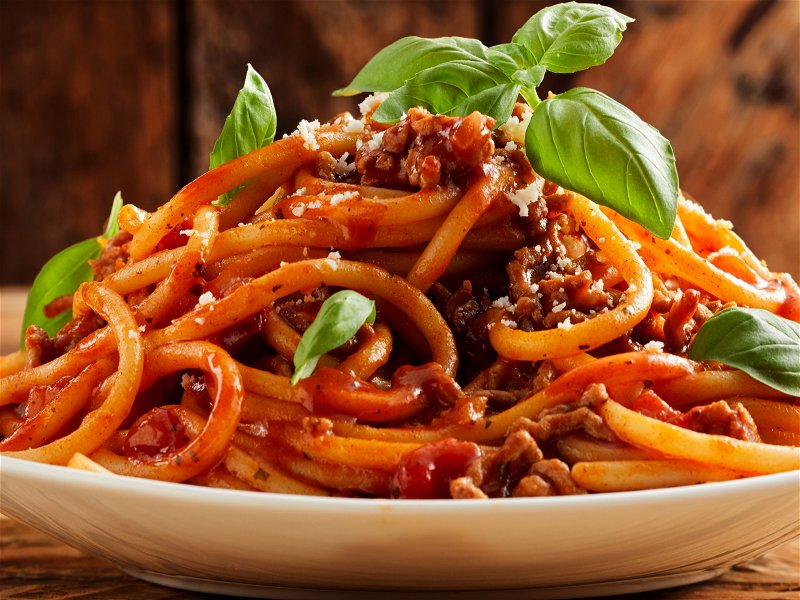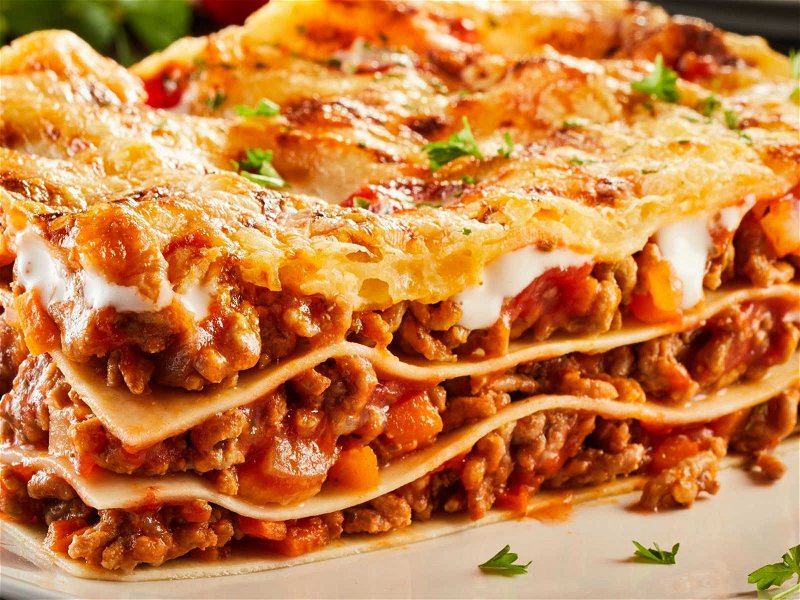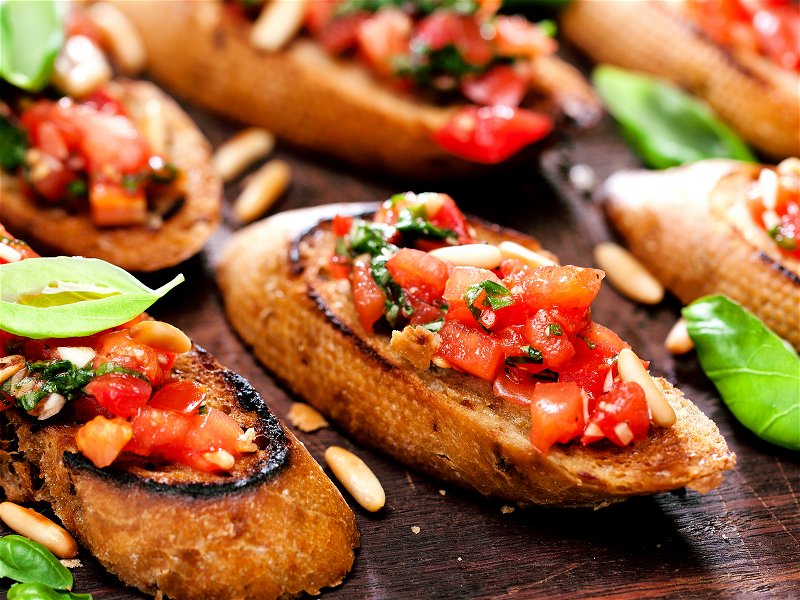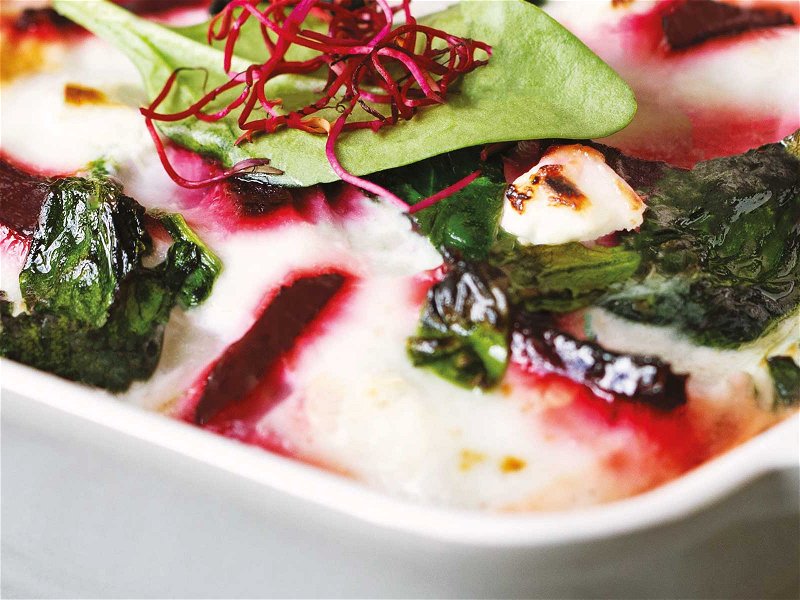Spaghetti Bolognese
Cookery teacher Julian Kutos shares his tips and tricks on how to make your own fresh pasta – and the secret to making a truly great Bolognese sauce.
For the sauce
| Ingredients | ||
|---|---|---|
| 2 | teaspoon(s) | olive oil |
| 100 | g | pancetta, chopped |
| 2 | garlic cloves, 1 whole and unpeeled, 1 sliced | |
| 2 | twigs | thyme |
| 25 | g | celery, finely chopped |
| 25 | g | carrot, finely chopped |
| 25 | g | onion, finely chopped |
| 15 | g | parsely, finely chopped |
| 500 | g | beef mince |
| 125 | ml | red wine |
| 700 | ml | tomato passata |
| 1 | bay leaf | |
| 1 | tablespoon(s) | sugar |
| 1 | pinch(es) | fleur de sel |
| pepper | ||
| 100 | ml | milk, warm |
Preparation:
- Prick the whole garlic clove several times with the tip of a knife.
- Heat the olive oil in a deep heavy-based pan, ideally cast-iron (use one with a lid). Fry the pancetta, thyme and garlic clove until lightly browned. Remove the pancetta from the pan and set aside.
- Add the celery, carrot, onion, parsley and sliced garlic clove to the pan and fry lightly without browning.
- When the vegetables are lightly browned, add the beef mince, season with salt and cook, stirring, until the meat is cooked through. Add the red wine, turn up the heat and cook until the wine has mostly evaporated.
- Add the tomato passata, bay leaf and sugar, stir well, cover and cook the sauce on a low heat – it should only bubble very slightly – for 4 hours.
- Finally, heat the milk in a saucepan (do not bring to the boil) and stir into the sauce. Remove the bay leaf, thyme sprigs and garlic clove. Season with fleur de sel, pepper and a dash of red wine and serve mixed into the cooked pasta.
Tip:
The finished sauce will last for several days in the fridge and is good for freezing.
For the pasta
| Ingredients | ||
|---|---|---|
| 250 | g | durum wheat semolina |
| 7–8 | medium egg yolks, lightly beaten | |
Preparation:
- Pile the flour onto a work surface, form a well in the centre and add the egg yolks.
- Starting from the outside edges, use your hand to bring the dough and the egg yolks together.
- When the flour and yolks come together into a ball, knead (by hand or using a food processor) for several minutes so that the yolks and the gluten in the flour combine.
- Shape the dough into a ball, cover with cling film and let it rest in the fridge for at least 60 minutes.
- If you have a pasta machine, fit it with the flat (lasagne) attachment at its thickest setting. Divide the dough in half and pass the dough through the machine. Reduce the thickness and pass the dough through again.
- Repeat this process several times, each time reducing the thickness slightly until the desired thickness (1mm) is reached. Repeat with the other half of dough. Dust with flour as needed.
- If you do not have a pasta machine, roll out the dough using a rolling pin until very thin, about 1mm thick, dusting with flour as needed.
- Roll up the pasta dough like a cigar and cut into narrow pieces (spaghetti 1mm, trenette 3mm, tagliatelle 7mm) from the roll using a sharp knife. Unroll the pasta and place carefully on a well-floured tray and leave to dry.
- To cook, fill a large saucepan with water, add salt and bring to the boil.
- Add the noodles and cook on high for a few minutes until they float to the surface. Drain and use immediately.
Tip:
Fresh pasta will last for 3 to 4 days in the fridge, or can be dried at room temperature.
Hints, tips & tricks
Why is the sauce diluted with milk?
Milk gives the sauce a nice light colour and makes it creamy. The sweetness of the milk makes the sauce very pleasant.
Why does the sauce have to cook for so long?
The secret ingredient for many dishes is time. The flavours need time to develop and unfold, similar to wine. Of course, the sauce can be cooked for a shorter time if necessary.
Bolognese sauce is actually called ragù in Italy. Ragù is cooked slightly differently in every region of Italy, which is why there are so many different recipes.
The wine does not play a dominant role in the sauce, but it does influence the overall taste. I recommend heavy, intense red wines, such as Merlot, Bordeaux or Port. Of course, white wines such as Pinot Grigio or Chardonnay are also suitable.
Why is pasta made from durum wheat semolina?
Durum wheat semolina is a special type of wheat that is ideal for pasta. Not only does durum wheat semolina have a beautiful light colour, but it is also ground coarser than normal flour, which improves the texture and provides the correct 'al dente' texture.
Why is only egg yolk used for pasta?
Egg yolk improves the taste, provides a nice yellow colour and the right bite. For economic reasons, whole eggs can of course also be used.
Why is the pasta dough not salted?
Salt makes the noodles brittle, so they are cooked in very salty water instead.
Why should you make pasta yourself, although you can buy very good ready-made pasta?
Fresh pasta is a special culinary experience that cannot be compared with normal pasta. Besides the taste experience, what counts most is the fun and pleasure of preparing it.
Which pasta goes with which sauce?
Italians love their large pasta repertoire, because each variety has the perfect characteristics for certain sauces. The rule of thumb is: liquid sauce with long pasta (spaghetti, tagliatelle, fettuccine, etc. ...), thick sauce (with coarse to large pieces) with short pasta.
As a universal pasta, Italians prefer to use tagliatelle, a ribbon pasta with a width of 6.5 to 10 millimetres.
